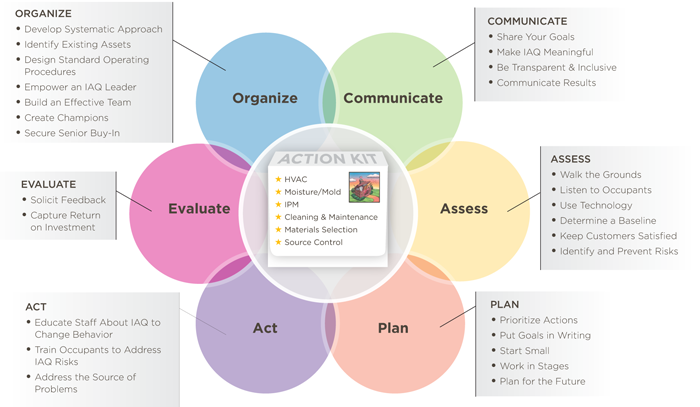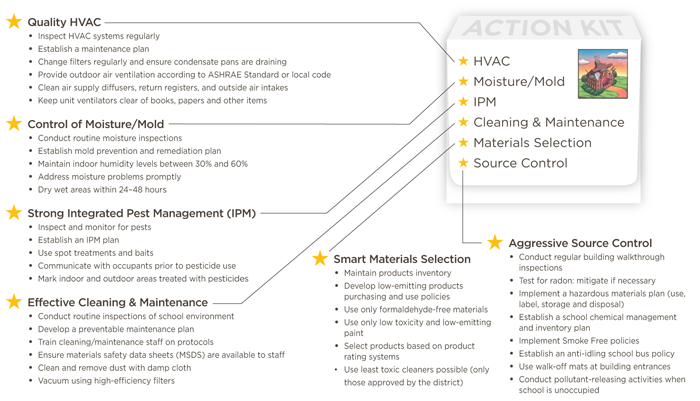IAQ Tools for Schools At-a-Glance for State School Environmental Health Guidelines
IAQ Tools for Schools is a flexible, comprehensive resource for environmental health in school buildings. The IAQ Tools for Schools approach provides strategies and a robust suite of tools to help schools identify, correct, and prevent a wide range of environmental health and safety risks, and to put in place a sustainable system to institutionalize a successful program at the school or school district level. The framework provides a common language to describe the drivers of IAQ program success; detailed guidance on the proven strategies, organizational approaches, and leadership styles that are fundamental to program effectiveness; and a clear vision of the pathway to school IAQ excellence. Its highly flexible and adaptable structure allows any school or school district, regardless of location, size, budget, or condition, to use the framework to launch, reinvigorate, and sustain an effective indoor air quality management program.
The Framework for Effective School IAQ Management: Six Key Drivers

The core elements of the IAQ Tools for Schools Framework are the Key Drivers and the Technical Solutions. The Key Drivers are the essential functions of effective and enduring indoor air quality management programs: Organize, Communicate, Assess, Plan, Act, and Evaluate. The Technical Solutions define the most common issues that schools need to address to effectively manage indoor air quality risks: Quality HVAC, Control of Moisture and Mold, Integrated Pest Management, Effective Cleaning and Maintenance, Smart Materials Selection, and Aggressive Source Control.
Learn more about the IAQ Tools for Schools Framework.
The Framework for Effective School IAQ Management: Six Technical Solutions

Quality HVAC
- Inspect HVAC systems regularly
- Establish a maintenance plan
- Change filters regularly and ensure condensate pans are draining
- Provide outdoor air ventilation according to ASHRAE Standard or local code
- Clean air supply diffusers, return registers, and outside air intakes
- Keep unit ventilators clear of books, papers, and other items
Control of Moisture/Mold
- Conduct routine moisture inspections
- Establish mold prevention and remediation plan
- Maintain indoor humidity levels between 30% and 60%
- Address moisture problems promptly
- Dry wet areas within 24-48 hours
Strong Integrated Pest Management (IPM)
- Inspect and monitor for pests
- Establish an IPM plan
- Use spot treatments and baits
- Communicate with occupants prior to pesticide use
- Mark indoor and Outdoor areas treated with pesticides
Effective Cleaning and Maintenance
- Conduct routine inspections of school environment
- Develop a preventable maintenance plan
- Train cleaning/maintenance staff on protocols
- Ensure materials safety data sheets (MSDS) are available to staff
- Clean and remove dust with damp cloth
- Vacuum using high-efficiency filters
Smart Materials Selection
- Maintain products inventory
- Develop low-emitting products purchasing and use policies
- Use only formaldehyde-free materials
- Use only low toxicity and low-emitting paint
- Select products based on product rating systems
- Use least toxic cleaners possible (only those approved by the district)
Aggressive Source Control
- Conduct regular building walkthrough inspections
- Test for radon; mitigate if necessary
- Implement a hazardous materials plan (use, label, storage, and disposal)
- Establish a school chemical management and inventory plan
- Implement Smoke Free policies
- Establish an anti-idling school bus policy
- Use walk-off mats at building entrances
- Conduct pollutant-releasing activities when school is unoccupied
